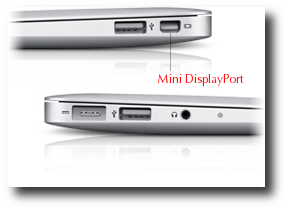
By the time you’re drawing a 5120×2880 image, transitions become flipbooks, and occasionally you won’t see any transitional animations at all. Naturally, this is much more taxing on the GPU, and the higher you go the jerkier the animations become. It accomplishes this by drawing a larger 4608×2592, 5120×2880, or 6016×3384 image and scaling it down to fit the 3840×2160 resolution of the display. If you use a Retina MacBook of some kind, you already know that OS X can scale its display to give you more usable screen space. Scale the display up and things become less pleasant. But things are more than smooth enough for desktop use.
#Mac air video output full
Dropped frames are clearly visible when entering into Full Screen mode or using Mission Control, and of course you’ll never want to try playing games or doing heavy 3D work at native resolution. Given that the Air is using one of Intel’s integrated GPUs, general OS X user interface performance isn’t too bad while driving the Air’s internal display alongside the 4K display. 4K is still far from a mainstream feature, but monitors like this one are as close as it’s ever been. Dell offers better displays if you need a pro-level color gamut, but it’s an IPS panel that covers 99 percent of the sRGB color space, so it will look great to most eyes.

We picked it because of its desk-friendly 24-inch size, because its stand will do all the tilting and pivoting that you’d ever need it to, and because it has a nice array of ports: an MHL-compatible HDMI-out, both full-size and Mini DisplayPort inputs, a four-port USB 3.0 hub, and a DisplayPort output for daisy-chaining.
#Mac air video output professional
We’re not really equipped to review monitors here my professional opinion of this one is “it’s very nice.” That’s not drastically more expensive than something like the well-regarded U2412M, which usually goes for around $300. Our choice, Dell’s 24-inch P2415Q, has only been on the market since December, and since then they’ve fallen from an MSRP of $600 to just south of $500. Using a single video stream (SST, or Single Stream Transport) is a cleaner solution, and luckily 60Hz 4K SST monitors are becoming more common and less expensive. If a given GPU can support a total of four displays, for example, using an MST connection eats up two streams and limits you to a total of three displays. While the DisplayPort 1.2 spec allows multiple DisplayPort streams to be sent over a single cable, using two video streams in this way does cut down on the number of monitors you can have attached to your system. If you’re a 2015 MacBook Air owner looking for more information about buying a 4K display, here’s what we can tell you.
#Mac air video output pro
Both Airs and the Pro had also made the jump to Thunderbolt 2, which explicitly supports DisplayPort 1.2. Intel’s documentation tells us that the new Broadwell-U processors and their integrated GPUs support output of up to 3840×2160 at 60Hz when connected using DisplayPort 1.2, where the Haswell versions were capped at 30Hz (4K over HDMI remains capped at 24Hz, a limitation of the HDMI 1.4 spec). That’s because unlike last year’s Airs and 13-inch Pro (and all older DisplayPort and Thunderbolt Macs), the new versions of the laptops have the correct combination of hardware that makes 60Hz 4K output possible. Last year’s Air connected to the same display with the same cable can manage, at best, a blurry 2560×1440. The short answer is that yes, both the Pros and Airs now support 4K output at 60Hz using a single DisplayPort 1.2 cable.

We were fairly sure that Apple’s spec page was incorrect, but to get a definitive answer we dove into the still-nascent 4K display ecosystem to do some testing.


 0 kommentar(er)
0 kommentar(er)
